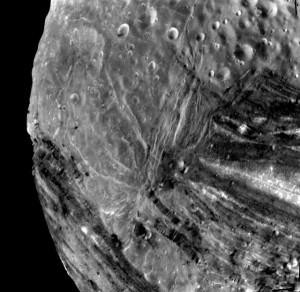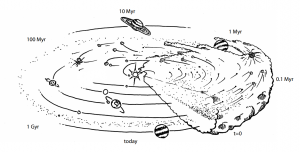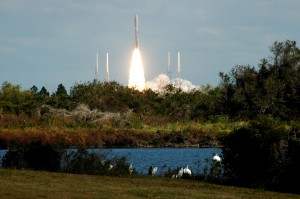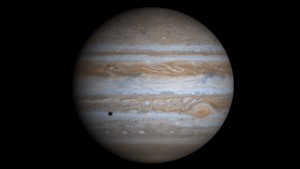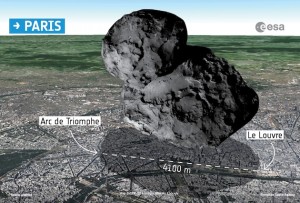Faqs
Solar System
The International Astronomical Union (IAU) is the formal authority for naming celestial bodies. Newly detected minor planets or asteroids get a provisional designation: For example 1989 SG1 was the 32nd object detected in the second half of September 1989. If the object’s orbit is confirmed it receives a permanent number and the discoverer is invited to suggest a name for it. So 1989 SG1 became 7934 Sinatra named in memory of the American singer. This process can take decades. So if you want to make sure that your own name is on the sky you have to discover a comet. Comet 67P/Churyumov-Gerasimenko that was visited by the European spacecraft Rosetta had been named after the Soviet astronomers Klim Ivanovych Churyumov and Svetlana Ivanovna Gerasimenko who had detected it in September 1969. The object is number 67 on the list of numbered comets with “P” standing for periodic.
Who is Miranda? She is the heroine in Shakespeare’s last play “The Tempest”, but Miranda is also the name of a moon of planet Uranus belonging to a set of exceptions. Whereas all of the planets in our solar system and most of the moons are named after Greek and Roman mythology the satellites of Uranus have names that were used by William Shakespeare or Alexander Pope. Dwarf planets also are named after gods, but the Greek and Romans don’t govern the sky alone any more. Haumea discovered 2003 is the Hawaiian goddess of fertility and Makemake found 2005 is a Polynesian creator god.
At the beginning there is a cloud of dusk and gas, as theory goes. The cloud collapses to form a star in the centre surrounded by a rotating disk. (Think of a spinning clump of dough flattening into the shape of a pizza.) Eventually small bits of the material in the disk begin to stick together somewhat like dust bunnies are formed. If they get larger they attract more material thanks to gravity. Planetesimals are formed that grow into planet embryos by collisions. How the embryos turn into big gas giants like Jupiter or small rocky planets like Earth is still discussed. Since the discovery of the big exoplanets that are very near to their host stars most astronomers think that the planets probably migrate through their planetary system during formation. With computer models they try to simulate the process.
http://nccr-planets.ch/research/projects/project-6/
At the moment, only five celestial bodies were defined as dwarf planets by the International Astronomical Union (IAU): Pluto, Makemake, Haumea and Eris in the Kuiper Belt (beyond Neptune) and Ceres, in the asteroids belt between Mars and Jupiter. Candidates are Sedna, Orcus, Quaoar and Varuna, all trans-Neptunian objects.
http://solarsystem.nasa.gov/planets/profile.cfm?Object=Dwarf
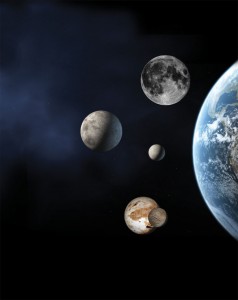
Artist’s view of Eris (left), Pluto with Charon (bottom), Ceres (middle), Moon (top) and Earth. Credit: NASA
Pluto has long been considered the 9th planet and the farthest away from the sun. But since the discovery of another body with a comparable size to Pluto beyond the orbit of Neptune, the classification of Pluto was reconsidered by the International Astronomical Union (IAU). Pluto is spherical and revolving around the sun, however it is not alone in the area and forms part of the Kuiper Belt where other dwarf planets like Haumea and Makemake have been discovered recently.
http://www.nasa.gov/mission_pages/newhorizons/main/
The word “planet” originally discribed “wanderers” that moved over the sky in contrast to the “fixed stars”. Only since 2006 there has been an official scientific definition. According to the International Astronomical Union (IAU) to be considered a planet, a celestial body must meet three conditions:
- Be spherical (in hydrostaticequilibrium)
- Turn around its star
- Be in a region where it is alone.
In our solar system there are eight planets: Mercury, Venus, Earth, Mars, Jupiter, Saturn, Uranus and Neptun.
http://www.iau.org/news/pressreleases/detail/iau0603/
It is believed that comets and asteroids are the relics of the material that formed the solar system. They would not have evolved and could inform us about the chemical composition, the size, and the formation process of the protosolar nebula. It was long thought that the water found on Earth came from comets, but according to the latest results from Rosetta (ESA’s probe on the Churyumov-Gerasimenko comet) and Dawn (NASA’s probe on the Vesta and Ceres asteroids), it seems more likely that it comes from asteroids.


